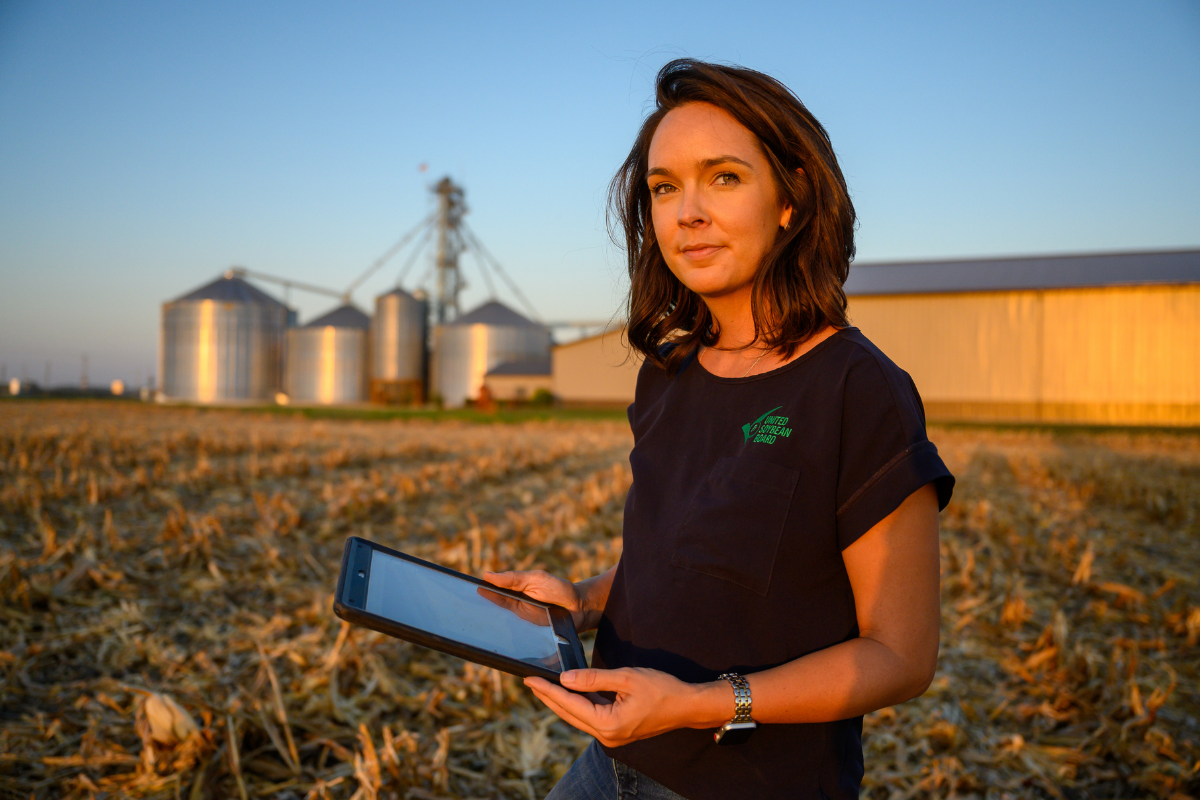The Future of American Farming Demands High-Speed Internet Solutions

A new report from Benton Institute for Broadband & Society recommends steps for connecting the farm office, field and community.
ST. LOUIS (Oct. 27, 2021) — A new report, funded by the United Soybean Board (USB) and conducted by the Benton Institute for Broadband & Society, revealed that providing U.S. farmers and ranchers access to fast, affordable and reliable broadband will increase sustainability. It will also allow more reliable and efficient food production for a growing population and strengthen America’s rural communities.
“Data is the most valuable tool in our farm’s toolbox. Without a reliable connection to the internet, data collection and its subsequent use is severely limited,” said Meagan Kaiser, USB treasurer, soil scientist and Missouri farmer. “Data gives us the ability to identify plant nutrient requirements and target those nutrients only where they are needed, which leads to increased yields without expanding acreage. It all begins with connectivity.”
Interviews with farmers, rural internet service providers, equipment manufacturers, and agricultural leaders and experts revealed consensus around several key outcomes for rural broadband, such as the need for robust upload speeds, accurate network deployment data and scalable technologies.
The report, The Future of American Farming: Broadband Solutions for the Farm Office, Field, and Community, lays out 15 actionable recommendations for delivering the high-speed internet that farmers and rural communities need. Categorized by the farm operations center, wireless needs in the field, and how reliable broadband can support the interdependent relationship between farmers and their rural communities, some of the actionable recommendations include:
- Establish future-proof performance standards: To meet the growing demand among farmers for both upstream and downstream speeds, networks must be capable of 100/100 Mbps service.
- Adopt high-performance standards: Performance standards for upload speeds and latency should reflect the changing needs of the farmers for precision agriculture.
- Encourage deep fiber build-out: Fiber build-out in rural America, even if not directly to the farm, will be needed to support capable wireless connections for higher-bandwidth applications in the field.
- Address gaps in mapping on farmland: Broadband maps should include mobile coverage on agricultural lands. The underlying data that informs these maps must be available to the public.
- Support equity digital programs at the state and local levels: Digital equity programs can work with communities to help people make full use of broadband connections.
“To many farmers, sustainability incorporates the economic, environmental and social impacts of agriculture — a triple bottom line,” said Jordan Arnold, research associate for the Benton Institute for Broadband & Society and the report’s author. “Now it’s time to deploy the broadband networks and adoption strategies they need.”
The recommendations are a direct response to the problems revealed in a 2019 rural broadband study from USB. This initial study showed 60% of U.S. farmers and ranchers do not believe they have adequate internet connectivity to run their businesses, and that plans to incorporate data into day-to-day decisions are often thwarted by slow internet speeds, high costs and unreliable service. The study also noted that many farmers do not have another viable option to change internet service providers.
Even hampered by these issues, farmers know that broadband is a necessary tool to implement innovative agricultural practices and allow for more targeted and efficient resource use. Broadband access lets farmers measure their inputs and outputs more efficiently, which creates smarter, more sustainable resource management.
“Connectivity of land, equipment and infrastructure drives the ability to proactively manage digital data at the farm and ranch level. Managing digital data drives precision agriculture, and precision agriculture drives many foundational aspects of measurable sustainability,” said Mace Thornton, vice president of communications and marketing strategy for USB. “That is why this issue is so vital to soy.”
To read the full report, visit https://www.benton.org/publications/future-american-farming.
About the United Soybean Board
United Soybean Board’s 78 volunteer farmer-directors work on behalf of all U.S. soybean farmers to achieve maximum value for their soy checkoff investments. These volunteers invest and leverage checkoff funds in programs and partnerships to drive soybean innovation beyond the bushel and increase preference for U.S. soy. That preference is based on U.S. soybean meal and oil quality and the sustainability of U.S. soybean farmers. As stipulated in the federal Soybean Promotion, Research and Consumer Information Act, the USDA Agricultural Marketing Service has oversight responsibilities for USB and the soy checkoff. For more information on the United Soybean Board, visit unitedsoybean.org.
About the Benton Institute for Broadband & Society
The Benton Institute for Broadband & Society is a nonprofit organization dedicated to ensuring that all people in the U.S. have access to open, affordable, high-performance broadband, regardless of where they live or who they are. We believe communication policy — rooted in the values of access, equity and diversity — has the power to deliver new opportunities and strengthen communities. For more information on the Benton Institute for Broadband & Society, visit benton.org.
###
Contact:
Paul Murphy-Spooner at United Soybean Board, 515.975.6584.
Mace Thornton at United Soybean Board, mthornton@unitedsoybean.org.
Adrianne Furniss at Benton Institute for Broadband & Society, afurniss@benton.org.
